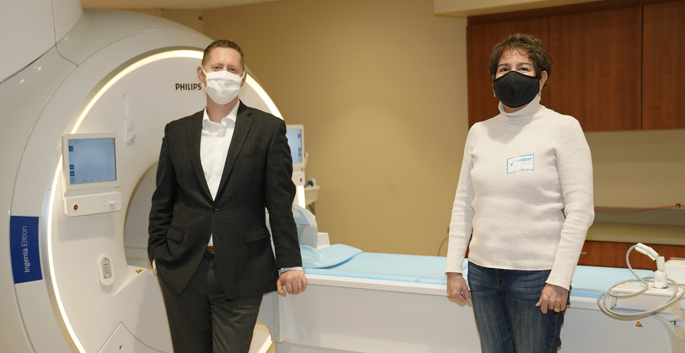
Victoria Morgan, PhD, and Allen Timothy Newton, PhD, both biomedical engineers and faculty of the Department of Radiology and Radiological Sciences, have teamed up with Stephen Wilson, PhD, associate professor of Hearing and Speech Sciences, to offer brain function mapping services to Vanderbilt brain surgeons and their patients.
Patients are often overwhelmed or scared after finding out they need to undergo brain surgery. Operations are invasive and involve many unknowns, but Morgan, Newton and Wilson believe that pre-operative brain mapping can make surgeries safer and help calm some of those fears.
Brain mapping, also called functional imaging or functional MRI, is a procedure where patients perform different linguistic and motor tasks while in an MRI scanner. Pictures of the brain are taken while tasks are performed, leaving Morgan, Newton and Wilson with a map that shows increased blood oxygen levels in certain areas. These levels indicate which areas of the brain were used by the patient to perform the task. The map is then presented to neurosurgeons, informing them of vital functional areas that need to be approached with particular caution.
“When any kind of brain surgery is going to be done, it’s important to avoid areas that house non-recoverable functions as much as possible,” said Wilson. “We use imaging beforehand to map out functions so the surgeon can take that into account as they plan the surgery.”
Linguistic tasks patients perform include generating words that begin with a certain letter, completing sentences and word associations. Each linguistic task lasts 240 seconds. Motor and visual tasks such as finger and foot tapping can also be performed, taking 200 seconds each.
For functional imaging to work, patients must be able to lie still, read directions quickly and follow them precisely. Newton offers the same kind of functional imaging services to children and says these requirements can present unique challenges when children are involved. Often, alternate strategies are used to ensure pediatric patients and their surgeons are provided with the highest quality images.
Alternate strategies include modifying adult tasks to be more child-oriented, such as factoring in different reading levels for linguistic tasks. Many times, radiologists partner with the Patient Awake While Scanned (PAWS) program to counsel children to be better prepared for the MRI. “Functional MRI allows us to get high quality functional maps of the brains in children, while also reducing their exposure to radiation and unnecessarily invasive procedures as much as possible,” Newton said. “It takes a variety of strategies, and a large team of people, to maximize success for the wide variety of pediatric patients we serve.”
While many parts of the brain are consistent from person to person, significant details can vary. “Most people’s language function is in the left hemisphere of the brain, but some have language in the right hemisphere instead,” Wilson said. This means if language is housed in the left hemisphere and surgery is on the right, surgeons are able to be more aggressive.
Conversely, if language is housed in the left hemisphere and surgery is also on the left, the surgery needs to be more careful and tailored.
Wilson estimates that 80% of Vanderbilt brain mapping appointments for adults are patients who have epilepsy. Knowing exactly where language functions are is especially important for these patients, as atypical language organization is more common in people with epilepsy compared to the general population.
Alternatives to brain mapping include a procedure where the patient’s skull is opened up and electrical currents are applied to different areas of the brain. Patients perform similar motor and linguistic tasks, but when functions stop working due to electrical stimulation, doctors can presume the part of the brain they’re stimulating controls that function.
Morgan says the main benefit of brain mapping with functional MRI is that it is minimally invasive, resulting in less stress for patients. “Functional imaging is totally non-invasive. Instead of having to open up the skull, we can use an MRI to see brain oxygenation levels and provide similar information as a more invasive procedure.”
Morgan has performed more than 500 adult brain mapping procedures. “I enjoy getting to do something hands-on and using my engineering knowledge to directly help patients. I feel lucky to have this dimension to my work in addition to my research,” she said.
She explains that brain mapping has long been a tool for research but was only implemented in a clinical setting at Vanderbilt when requested by Reid Thompson, MD, the William F. Meacham Professor of Neurological Surgery and chair of the department, in 2005. “Over time, we went from a handful of patients to hundreds,” said Morgan.
Together, Morgan, Newton and Wilson can scan a patient’s brain, create a map and interpret the images for surgeons and their patients.
They have successfully forged a partnership between the Department of Radiology and Radiological Sciences and the Department of Hearing and Speech Sciences, which directly benefits the Department of Neurological Surgery and its patients.
“It’s a great example of the ways we work together at Vanderbilt,” Morgan says. “We are not clinicians, but we are able to bring our expertise to help our neurosurgeons deliver technologically advanced patient care.”












